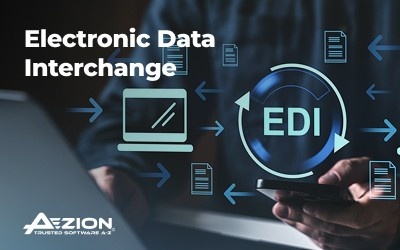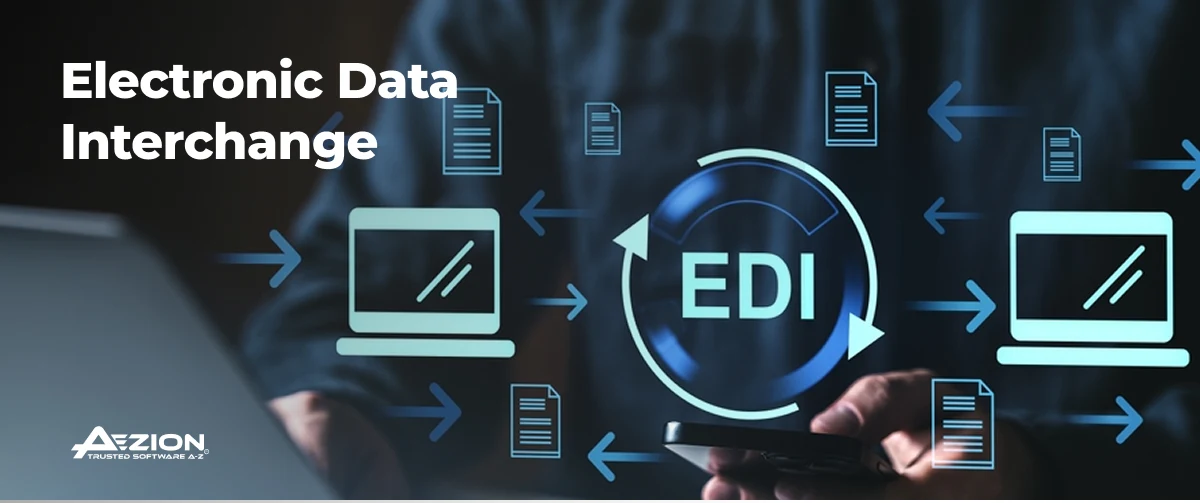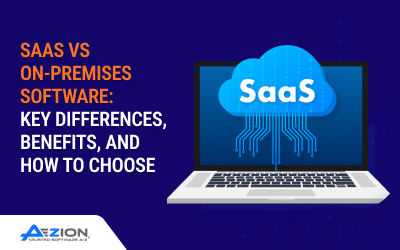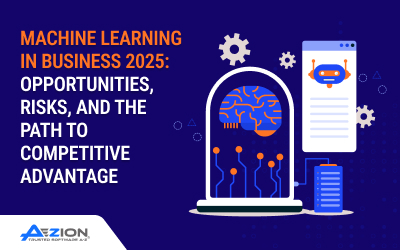Summary
Electronic Data Interchange (EDI) is an industry-standard layout to exchange business data electronically. It enables the electronic transfer of formatted documents between different business systems. This blog discusses EDI’s operation, types, advantages, typical challenges, and integration of EDI with the help of proper data engineering practices.
Introduction
In a fast-growing digital economy, businesses prefer to have a system through which important data and documents can be shared instantly and accurately. Electronic Data Interchange is proving to be a game-changer by offering an expandable and secure solution to organizations looking to minimize manual mistakes, automate operations, and improve partner relations.
With EDI, businesses can reduce paper-based communication and automate data exchange. For instance, invoices, shipping notes, and purchase orders that are shared between two businesses can be shared with the help of EDI. In today’s time, data engineering operations have become the center of any business, as EDI acts as a gateway connecting enterprise applications by offering data harmony through smooth connectivity.
Because of EDI’s growing importance and use, the global Electronic Data Interchange (EDI) software market is projected to grow from USD 2.31 billion in 2025 to USD 5.30 billion by 2032.
Now, let’s dive into this blog and learn more about Electronic Data Interchange (EDI).
What is Electronic Data Interchange?
Electronic Data Interchange (EDI) refers to the computer-to-computer formatted exchange of business documents. It follows a standardized format for intercompany document sharing. It enables businesses to automatically and securely exchange important data between software systems.
This approach has eliminated manual procedures, delays, and risks of data mishaps. Although it is not a new technology, it is still popular among companies because of its use in ERP, CRM, and supply chain systems. Implementing this approach with wider data engineering strategies can help companies consolidate data and increase efficiency in business operations.
How Does Electronic Data Interchange Work?
Before initiating EDI, knowing how information is transferred from one system to another is important. The system includes translating business documents into a standard form and transmitting them electronically through secure channels. Using EDI automates the business processes like mailing and creates a digital relationship between partners.
For any business, the internal system extracts data in the proper format from an application, such as a procurement system or ERP. The data in such applications is then translated into standardized EDI using specific software. Later, the document is shared using secure protocols such as AS2 or FTP. On the receiving end, the document is converted into an understandable format.
Types of EDI Systems
This approach has no one-size-fits-all strategy; companies must choose the right type according to their business size, integration requirements, and technical capabilities. Now, let us look at the types of Electronic Data Interchange systems.
- EDI over VAN: A third-party service provider transmits the data, providing facilities such as data encryption, routing, and auditing. This option minimizes complexity and is best for firms that internally lack EDI skills.
- Direct EDI: This method directly connects the two trading partners. It gives more control but is more complicated to set up and maintain, so high-transaction-volume businesses best use it.
- Mobile and Cloud-based EDI: These solutions connect directly with cloud ERPs or applications, allowing real-time document exchange through APIs. They provide flexibility, quicker onboarding, and easier management, which is particularly beneficial for organizations updating their data engineering architecture.
- Web EDI: This cloud-based EDI lets users send documents through a web browser. It’s typically used by small to mid-sized companies that need EDI functionality without spending much on infrastructure.
Common EDI Document Types
Now, let us understand the types of documents that EDI accommodates. It comes with many standard documents that are often shared between business partners. Each document is formatted and coded differently.
Some of the most popular Electronic Data Interchange document types are:
- EDI Invoice or EDI 810: The suppliers use an electronic billing document to request payment against services or goods provided.
- Inventory Inquiry or EDI 846: It gives the business owner up-to-the-minute inventory information.
- Purchase Order (PO) or EDI 850: This document type is very popular. EDI 850 enables buyers to order automatically and speeds up procurement.
- Order Acknowledgement or EDI 855: It is an EDI document that states the receipt of a purchase order and the requirement for its fulfillment.
- Advance Ship Notice (ASN) or EDI 856: It informs the buyer about the in-transit shipment.
Electronic Data Interchange Standards and Protocols
For EDI to be efficient across different systems, specific standards and communication protocols must be incorporated. Here we will have a look at some of the most acknowledged Electronic Data Interchange standards:
- EDIFACT: Electronic Data Interchange for Administration, Commerce, and Transport is a worldwide EDI standard by the United Nations. It enables businesses to send and receive business documents.
- HL7: It is a healthcare-specific protocol centered around clinical and administrative data exchange.
- ANSI ASC X12: The American National Standards Institute has created the Accredited Standards Committee to form EDI rules for the retail, healthcare, and logistics industries.
Widely used EDI protocols are:
- AS2: Applicability Statement 2 protocol enables businesses to secure, internet-based, encrypted data transfer with non-repudiation.
- FTP/SFTP: These standards are used to transfer files.
- HTTP/HTTPS: These are web-oriented protocols used in cloud EDI solutions.
Benefits of Implementing EDI
Significant advantages of implementing Electronic Data Interchange are:
Better Accuracy
EDI helps data engineers minimize the possibility of manual data entry errors, such as document loss. The standard formats incorporated in EDI enable accurate and consistent data interpretation, resulting in precise information exchange between businesses.
Scalability
EDI solutions help businesses easily scale to support increasing transaction volumes. With scalability, companies can make sure continued efficient and effective data exchange.
Regulatory Compliance
Industries are subject to specific regulations regarding data exchange and record maintenance. EDI helps organizations comply with such regulations through standardized and traceable electronic records. Adherence to these regulations can save companies from expensive fines.
Time and Cost Saving
EDI offers considerable time and cost savings. It uses machine processing for paper-based transactions, eliminating manual handling, saving time and effort, and reducing processing delays.
Improved Efficiency
Electronic Data Interchange eliminates significant manual data entry and makes the exchange of business documents easy. This increases system efficiency by automating processes.
Improved Business Relationships
Better communication and collaboration through a standardized and efficient data exchange process help businesses have more stable business relationships. With EDI, business partners can rely on timely and accurate information as per their data strategy.
Industries That Rely on Electronic Data Interchange
Electronic Data Interchange originated with the logistics and manufacturing industry. But with time, its impact on different industries has been incredible. It has replaced paper-heavy processes and reduced operational costs in industries like:
- Healthcare: Hospitals and insurance companies use this approach to share patient data, billing information, and more by aligning with regulatory compliance.
- Retail and eCommerce: EDI assists retail and eCommerce companies in having access to real-time information about inventory, order status, and shipping.
- Finance and Insurance: The banking sector can mechanize payments, invoice reconciliation, and claims processing by making use of Electronic Data Interchange.
- Logistics/Transportation: Trucking companies depend on EDI to print shipping labels, arrange deliveries, and provide ASN.
- Manufacturing: Suppliers and OEMs use Electronic Data Interchange to produce production schedules, coordinate procurements, and monitor manufactured products.
How to Implement EDI in Your Business
Implementing Electronic Data Interchange is a strategic move. Organizations hire data engineering experts who plan, check technical readiness, and align the transformation with business goals. Whether adopting EDI for the first time or migrating from a legacy setup to a structured approach, long-term success is guaranteed.
To implement EDI, data engineers follow these steps for any business type:
- First comes evaluating existing systems and determining which documents and processes will benefit most from EDI automation.
- Then, according to the size of the business and its technical capability, the right kind of EDI system is selected: direct, VAN-based, or cloud-enabled.
- After selecting the EDI system, the next step is integrating it with the business’s ERP, CRM, or warehouse systems. This is managed by experienced data engineering teams that can normalize and route data reliably.
Reasons Why Your Electronic Data Interchange Isn’t Working
A few common reasons why EDI systems fail to operate include:
- Inadequate Data Mapping: Incompatible field mapping of internal systems to EDI formats leads to processing errors and data inconsistencies.
- Outdated Standards or Protocols: Using old formats or insecure protocols could lead to compatibility or compliance issues with trading partners.
- No Integration: Without close integration of EDI with ERP or supply chain systems, users must intervene manually, negating the automation benefit.
- Internal Expertise constraints: Without data engineering expertise, organizations cannot support, troubleshoot, and scale EDI operations.
- Ineffective Partner Onboarding: EDI calls for coordination across standards and workflow; inadequate onboarding leads to failed transactions and miscommunication.
How Aezion Assists Businesses with EDI Integration
At Aezion, we realize that effective EDI implementation is essential for any business. Therefore, we help organizations from different industries to have a data environment that addresses their business requirements. Here is how Aezion facilitates EDI integration:
- System Integration: Our engineers make sure that EDI works smoothly with your business systems, such as ERP, CRM, warehouse, and other business-critical applications.
- Tailor-Made Solutions: We analyze the client’s company’s workflows, infrastructures, and trading partners to design EDI integration, keeping business processes in mind.
- Data Engineering: With extensive data engineering expertise, we offer automated pipelines and secure, direct EDI documents in real time.
- Support & Optimization: We offer end-to-end monitoring, support, and optimization to keep your EDI systems compliant, reliable, and future-proof.
Conclusion
Electronic Data Interchange (EDI) is known as a foundational pillar of digital business change. It enables organizations to eliminate human inefficiency, expedite transactions, and grow operations cost-effectively. With the right data engineering strategy, EDI benefits with document transfer for every business type and size. This means that, if EDI is implemented correctly, it can offer a scalable solution according to the business landscape.
Contact our data engineers to learn about our Data Engineering Services and how we can help with your EDI and automation plans.
FAQs
Is Electronic Data Interchange limited to large business enterprises?
No. Although large enterprises primarily use it, EDI can be used by small and medium enterprises to smooth their business processes.
How long does it take to implement an EDI system?
Implementation time mainly depends on the company’s size and the complexity of the documents.
Why choose Aezion to implement EDI?
Aezion has expertise with domain knowledge and sophisticated data engineering skills to deliver tailored and secure EDI integrations.




